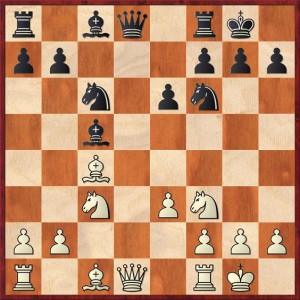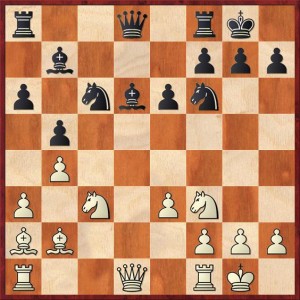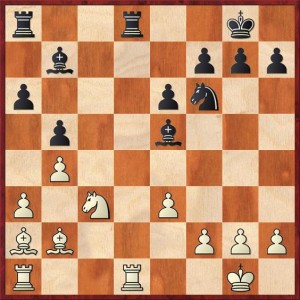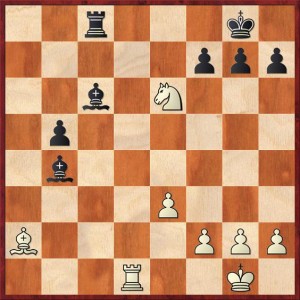This Sunday I had the chance to meet with Gjon Feinstein, Mike Splane, and Eric Montany at a coffeehouse to go over my recent game with Ivan Ke. (See this post for some earlier discussion of the game.) We tore apart and dissected the game until there were only the smallest bones left, and I learned a lot from the collective wisdom of three National Masters.
I will refer to all three of them together as The Hive Mind. I’m doing that partly to be funny, but also to give them plausible deniability. If they got something wrong, they can always blame it on the other two members of the collective. Also, it’s an appropriate term because hive minds do not always have to be consistent with themselves.
So here’s the first turning point in the game, where The Hive Mind criticized my play. I was Black, and Ke-Mackenzie reached this position after White’s ninth move.
 Position after 9. Bxc4. Black to move.
Position after 9. Bxc4. Black to move.
FEN: r1bq1rk1/pp3ppp/2n1pn2/2b5/2B5/2N1PN2/PP3PPP/R1BQ1RK1 b – – 0 9
First of all, some of you might find it hard to believe that we reached this position with Black to move, because the position is symmetrical. Yes, it is correct. I had hoodwinked my young opponent into losing a tempo already, so in effect Black is White and White is Black. Here are the opening moves in case you want to check: 1. d4 Nf6 2. c4 d5 3. Nc3 c5 4. e3 Nc6 5. dc e6 6. Nf3 Bxc5 7. Be2 O-O 8. O-O dc 9. Bxc4.
One interesting thing about this is that the position appears in ChessBase many times (more than 200) but almost always with White to move. So when I cite previous games below, it will always be with colors reversed. Hopefully that won’t be too confusing.
So the first thing that the Hive Mind (at least one member thereof) said here, and quite forcefully, was that they thought the best move for Black here is 9. … Qe7. That surprised me, because I thought that the move I chose, 9. … a6, was quite normal. And in fact, it’s played about three times more often than 9. … Qe7 in the database. But there is a valid point behind 9. … Qe7. If white continues copying Black’s moves, it leads to immediate disaster after 9. … Qe7 10. Qe2 e5! 11. e4 Bg4! (this is the point) and now copying is no longer possible because after 12. Bg5 Nd4 would be winning.
If White can’t meet 10. … e5 with e4, then he is in trouble because Black will follow up with 11. … e4 and get a strong kingside attack. See, for example, any classic game with the Colle System.
However, I still don’t think that the Hive Mind was completely right here. It’s true that White should not continue copying with 10. Qe2, but there are some other good alternatives. White can play 10. a3 as in the game, or perhaps even better, he can even try to get the jump on Black by playing 10. e4 himself. I don’t think that there is anything like a clear advantage for Black here. But it is still an interesting idea, and one of the things I like about it is that there is an actual plan behind Black’s move 9. … Qe7. He’s not just developing pieces for the sake of developing.
Okay, let’s carry on with the game. From the diagram I played 9. … a6 and Ke replied 10. a3 b5 11. Ba2?!
This is a mistake because the bishop ends up kind of out of play here. Either 11. Be2 or 11. Bd3 would be better, and indeed they are considerably more popular in ChessBase.
I continued 11. … Bb7 (11. … b4 would be an interesting possibility, to make the position more asymmetric) 12. b4 Bd6 13. Bb2 and we now reach the second diagram.

Position after 13. Bb2. Black to move.
FEN: /1b3ppp/p1nbpn2/1p6/1P6/P1N1PN2/BB3PPP/R2Q1RK1 b – – 0 13
Here I played 13. … Qe7 and I expected the Hive Mind to be happy because this was the move they recommended earlier. But no! They thought that 13. … Qe7 was inconsistent with the plan of fianchettoing the queen bishop. After all, the idea behind … Qe7 was to play … e5 and … Bg4. It’s not the moves themselves, but the ideas that are important.
Instead the Hive Mind proposed a really interesting idea. “Look at the pieces,” they said. “Wouldn’t you like to take the opportunity to trade your worst minor piece for White’s best one? So let’s play 13. … Ne5!”
During the game I may have considered 13. … Ne5, but I discarded it because I thought that too much material would come off the board. A typical superficial assessment by me. There’s more to it than that. If White decides to trade off a bunch of material with 14. Nxe5 Bxe5 15. Qxd8 Rfxd8 16. Rfd1, we get to a position that has appeared (with colors reversed) five times in ChessBase.
 Position after 16. Rfd1 (analysis). Black to move.
Position after 16. Rfd1 (analysis). Black to move.
FEN: r2r2k1/1b3ppp/p3pn2/1p2b3/1P6/P1N1P3/BB3PPP/R2R2K1 b – – 0 16
Every game with this position has ended with a draw. And every time it was because the players, like me, didn’t realize the dynamic potential in Black’s position. The most egregious offender, because it involved super-GM’s, was the game Szabo-Pachman from the Portoroz Interzonal in 1958, where Szabo (remember, White is Black and Black is White) meekly played 16. … Rdc8. Right idea, sort of, but wrong move order. The correct move here, as the Hive Mind said, is 16. … Ne4!, which continues to put pressure on the weak points in White’s position, specifically the pinned knight on c3.
Now I can’t quite credit Hive Mind with a Theoretical Novelty, because 16. … Ne4 has in fact been played once before, in the game Golubka-Stopkin, Chervonograd 2008. (These are not household names, but at least they are solid 2200-plus players.) However, Golubka botched it, because after 17. Rxd8+ Rxd8 18. Rd1 he played the peaceful 18. … Rxd1+? This trades too much and leads to a position where White can hold pretty easily after 19. Nxd1.
Instead Black has two good possibilities for turning up the pressure. One, found by Rybka (not Hive Mind), is the surprising 18. … Nd2! This seemingly walks into a pin, but White can’t exploit it and meanwhile Black threatens 19. … Bxc3 followed by 20. … Nf3+, breaking the pin and winning an exchange. Rybka rates the position after 18. … Nd2 as +0.6 for Black.
But that’s a little bit computer-y; it’s very unlikely that I would have come up with it over the board. Much more consistent with Black’s plan is 18. … Rc8!, and it also leads to a very comfortable position for Black. Here is what Rybka gives as best play from there: 19. Nxe4 (forced) Bxb2 20. Nc5 Bc6 21. Nxa6 Bxa3 22. Nc5 Bxb4 23. Nxe6! (see diagram).
 Position after 23. Nxe6. Black to play.
Position after 23. Nxe6. Black to play.
FEN: 2r3k1/5ppp/2b1N3/1p6/1b6/4P3/B4PPP/3R2K1 b – – 0 23
If it weren’t for this tactical shot, White would just have been busted. Hive Mind did not see this during our analysis, and I think that is only to be expected. We are now ten moves beyond the last position that actually appeared in the game, which is my definition of Fantasy Chess.
Even though White still has drawing chances (Rybka rates it about +0.5 for Black), I would be super happy to get to a position like this as Black. Black has the two bishops, an open board to use them in, and an outside passed pawn. I think that someone like Magnus Carlsen would win this position for Black without breaking a sweat.
In summary, I like Hive Mind’s second idea, the idea of 13. … Ne5, much better than the first. Black gains an effortless advantage, and he does so by applying simple strategic principles. Exchange bad pieces for good ones, put pressure on the weak points, and don’t let the exchanges bother you too much. Weaknesses remain weaknesses even when the material is reduced. In fact, in some cases the exchange of material clears away all the distractions and really focuses the attention on the key features of the position — in this case, the pin on the c3 knight. Here as well as later in the game, Hive Mind insisted that the knight on c3 is not well placed at all.
That’s where I’ll stop for today. Now that you’ve seen moves 1-13 of this game and moves 30-36, you’re probably wondering what happened in the rest of the game. Well, what happened was a bit of a mess with mistakes by both sides, and I think it has somewhat less instructional value.



{ 4 comments… read them below or add one }
I have a vested interest in this post because I gave Eric Montany his Chessmaster title.
Indeed, I knew that Eric used to live in Colorado. But I’m curious how you “gave” him the title.
By the way, Eric says that he is feeling very tempted to get back into tournament chess. Travel and work kept him away for a while, but his work seems to have settled down to the point where he has time for chess again.
https://denverchess.com/games/view/1400/ericmontany-brianwall
[BlackTeam “10923344”]
[WhiteTeam “12664344”]
[Event “Winter Springs Open”]
[Site “Manitou Springs, Colorado”]
[Date “2012-12-02”]
[Round “4”]
[White “Eric Montany”]
[Black “BrianWall”]
[Result “1-0”]
[WhiteElo “2208”]
[BlackElo “2200”]
[ECO “B00”]
[NIC “QO.17”]
[Opening “St. George (Baker) (Brian Wall) defence”]
[TimeControl “40/2 no increment no delay, then Game/1 hour + 5 second delay”]
[Time “2 PM”]
[ICCResult “Black resigns”]
1. d4 a6 2. c4 b5 3. e4 Bb7 4. d5 e6 5. Nf3 bxc4 6. Bxc4 Nf6 7. Qb3 Qc8 8. Nc3 Be7 9. O-O O-O 10. Bg5 h6 11. Bh4 Re8 12. Rfe1 a5 13. dxe6 dxe6 14. Rad1 Na6 15. Qc2 Nc5 16. Nd4 Nh5 17. Bxe7 Rxe7 18. Qe2 Nf6 19. e5 Nfd7 20. a3 Nb6 21. Ba2 Qe8 22. Qc2 Na6 23. Bb1 g6 24. Qc1 Kg7 25. Ne4 Bxe4 26. Bxe4 Rd8 27. Re3 c5 28. Rh3 g5 29. Bc6 Red7 30. Bxd7 Rxd7 31. Nb3 Nd5 32. Nxa5 Qd8 33. Nc4 Nf4 34. Rxd7 Nxh3+ 35. gxh3 Qxd7 36. Qd2 Qd5 37. Qxd5 exd5 38. Ne3 Nc7 39. Kf1 Kg6 40. Ke2 d4 41. Nc4 Kf5 42. Kf3 Ke6 43. Ke4 Nd5 44. a4 f5+ 45. Kf3 Nb4 46. a5 Kd5 47. b3 Na6 48. Ke2 Nc7 49. Kf3 Kc6 50. Nd6 Kd5 51. Nxf5 h5 52. Ng7 Kxe5 53. Nxh5 Kd5 54. Nf6+ Kc6 55. Ne4 Kb5 56. Nxg5 Kxa5 57. Ne4 Ne6 58. h4 Kb4 59. h5 Kxb3 60. h6 Nf8 61. Nxc5+ Kc4 62. Ne4 Kd5 63. Nf6+ { Brian welcomes Eric to the Chessmaster Club December 2, 2012 }
1-0
fully annotated Brian Wall Eric Montany games at DenverChess.com or BrianWallChess@Yahoogroups.com if Eric dares to play again.